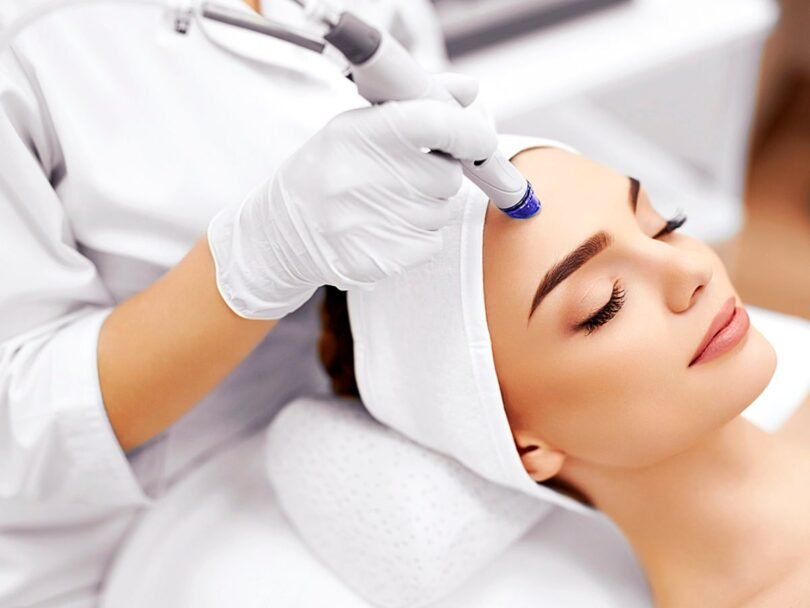What is Microneedling?
Microneedling is a cosmetic procedure that addresses a variety of skin conditions. Pricking the skin with small sterile needles is part of its procedure. A dermaroller is a microneedling device that uses micro-fine needles that are 0.5 to 2.5 millimetres in diameter. It is the most common (and cost-effective) microneedling device. Your body produces more collagen and elastin as a result of the tiny wounds, which cure your skin and make you look younger. Microneedling is usually done in a doctor’s office, however, it can also be done at home. The cost of microneedling is less than the cost of laser treatments.
Because microneedling is just not as invasive as plastic surgery, the recovery time is short. Within the first several days after the procedure, you likely experience skin irritation and redness. It is a natural reaction to the minor injuries inflicted by the needles. Sunscreen is also essential because your skin will be much more sensitive to the sun. You will need numerous sessions and possibly more treatments to sustain the outcomes of your treatment. Your doctor will recommend the best course of action for you depending on your specific goals.
Everybody has distinct target regions whenever it comes to using microneedle roller treatment. Acne scars, age spots (also known as “sun spots”), fine lines and wrinkles, big pores, other types of scars, Trusted Source, reduced skin, elasticity, and uneven skin tone are the most common targets for microneedling on the face. Microneedling can also be used to treat stretch marks on other parts of the body, in addition to facial issues. But microneedling, on the other hand, is predominantly utilized on the face.
Benefits of Microneedling
Microneedling can help with a range of problems, including:
- Wrinkles and Fine Lines
- Scars
- Alopecia
- Acne
- Sun Damage
- Stretch Marks
- Skin Pigmentation
- Large Pores
Difference Between Microneedling and Dermarolling?
You may hear the phrase dermarolling, so let’s understand the difference between microneedling and dermarolling. Microneedling utilizes vibration (which helps distract from the discomfort) and needle widths ranging from 0.25 mm to 3 mm, whereas dermarollers use fixed needles on a roller head (0.3 mm or smaller) to make ultra-tiny pricks in the skin.
Dermarolling is usually performed at home, whereas microneedling is performed in a clinic. Both devices puncture the skin’s surface layer (the epidermis), but dermarolling normally merely pricks the skin, facilitating increased product absorption, whilst microneedling goes a bit deeper, gently injuring it and initiating natural collagen and elastin formation.
What Are The Risks of Microneedling?
Microneedling, like every cosmetic procedure, carries some risk. The most common side effect immediately following treatment is minor skin discomfort. For a few days, you may even notice some redness. If you experience more serious side effects, such as bleeding, bruising, infection, or peeling, contact your doctor right away. Moreover, certain people aren’t good candidates for microneedling, such as those who have a skin infection that is active, acne breakouts, If you have keloid scarring, have an unstable skin type, or have recently had radiation therapy, even who are pregnant you should consult your doctor.
Always go for a dermatologist or medical skincare specialist who is knowledgeable with this procedure can help reduce the risks.
How Does Microneedling Work?
Microneedling causes trauma to the skin, which stimulates the creation of collagen and other healing factors. Collagen is a vital protein that keeps the skin tight, smooth, and flexible to keep it appearing youthful. Wrinkles and other indications of ageing are caused by the loss of collagen in the skin as people age. Injuries to the skin, including acne scarring, stretch marks, or other scars, can cause collagen loss. It’s vital to remember that microneedling is a long-term solution because it includes the formation of new skin.
To make the needle pricks less painful, a numbing lotion will be applied to your face. The microneedling specialist will then move a pen-shaped or rolling device containing tiny needles around your face. The needles create small wounds in your skin, resulting in some bleeding. Following that, your doctor may apply a lotion or serum to your face.
The procedure’s complete results can take many months to see. Depending on the size of the region, the procedure normally takes 10-20 minutes. The majority of people need 4-6 treatments to see results. Microneedling is most commonly used on the face, and it can also be used on other areas of the body, such as in the stomach or thighs.
Microneedling is a procedure performed by dermatologists. If you perform it somewhere other than a doctor’s office, ensure that the individual has the necessary experience and credentials and that all of the equipment is sterilized. Microneedling devices are available in the do-it-yourself form. However, specialists advise against using them since you risk injuring your skin and may not be able to disinfect the needles properly.
How To Prepare For Microneedling?
There is no need for any specific preparation, but there are some things to keep in mind. Consult your doctor before the procedure about how you can prepare so that you get the best potential outcome. Certain medications, such as ibuprofen and acne treatments, may need you to cease using them several weeks before the surgery. Your doctor could also advise you to cease taking topical retinoids before the procedure. Certain adverse effects may be reduced as a result of doing so.
The Takeaways
Microneedling is a dermaroller process that involves pricking the skin with small needles. The goal of the treatment is to stimulate the production of new collagen and skin tissue, resulting in skin that is smoother, firmer, and more toned. It has the potential to decrease wrinkles, scarring, and tighten or rejuvenate loose or aged skin. Microneedling is a typically safe and effective treatment for improving skin texture.
While home microneedling is more convenient and comfortable you can do it anytime than professional microneedling because you need to take time for your doctor prior, the outcomes will not be as good, and the risk of adverse effects will be higher. Microneedling is a better alternative than a store-bought roller device if you’re looking for more significant, long-term results.






